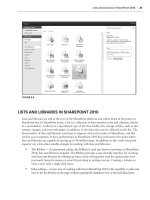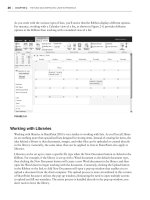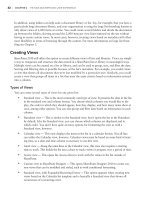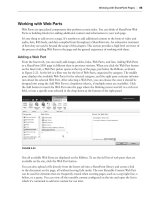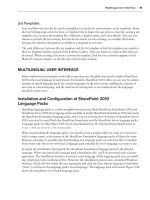Thủ thuật Sharepoint 2010 part 91 potx
Bạn đang xem bản rút gọn của tài liệu. Xem và tải ngay bản đầy đủ của tài liệu tại đây (838.98 KB, 8 trang )
Branding SharePoint 2010
WHAT’S IN THIS CHAPTER?
Understanding branding in SharePoint
Themes
Master pages
Page layouts
Cascading style sheets
Controlling access to branding in SharePoint
When you think of administering SharePoint, branding and user interface design is usually not
the fi rst thing that comes to mind. While most farm administrators are not very interested in
tweaking colors and fonts, you need to understand how the process works behind the scenes.
This is especially important with SharePoint because unlike many traditional web develop-
ment projects, SharePoint projects require a high level of interaction between IT professionals,
administrators, designers, and developers. As designers and developers create user interfaces,
administrators need to ensure that those design assets live and play well with everything else
that is part of a SharePoint farm.
WHAT IS BRANDING?
Branding is the act of creating a specifi c image or identity that people will recognize in rela-
tion to a company. When you think of Coca-Cola, you probably fi rst think of their distinctive
red and white logo; and when you think of United Parcel Service (UPS), the fi rst image that
comes to mind is either their brown trucks or uniforms. When you see these colors, you are
immediately reminded of the products or services for which each of these companies is known.
One reason is probably because of all the advertising that bombards you on a daily basis; but
it’s also because both of these companies have a strong branding strategy, one that permeates
all of their products and advertising, including their websites.
23
684
CHAPTER 23 BraNdiNg sharePoiNt 2010
For websites, branding usually refers to the colors, font, and images that are seen on the page, as
well as the HTML, CSS, and images that together make that page render properly. Branding for
SharePoint websites includes all of this, but it also refers to technologies such as master pages, page
layouts, and Web Parts.
This concept has been traditionally known as design, or more specifically user interface design. The
term “branding” is used frequently with SharePoint projects because the word “design” often means
different things to people in other technology roles. In enterprise software projects, “design” often
refers specifically to the act of planning and architecting a software application. To alleviate this
confusion, the term “branding” has become quite popular in recent years to refer to the act of creat-
ing an effective user interface design.
UNDERSTANDING YOUR REQUIREMENTS
Because SharePoint is a big product that can be used to solve a lot of IT problems, it’s a good idea
to spend some time up front thinking about your specific project requirements. This process typi-
cally involves asking a lot of questions in order to break down the large goal of having a successful
SharePoint site into smaller requirements that can be measured and achieved. The act of branding
a SharePoint site is no different; there are a few specific high-level decisions that need to be made
before starting, such as which edition of SharePoint will be required to achieve the project goals or
what the intended audience expects to see or not see on the page. The following sections will discuss
a few high level considerations that should be made based on your project’s requirements.
SHAREPOINT VERSIONS AND PUBLISHING
As discussed in Chapter 3, SharePoint 2010 is available in several different versions. SharePoint
Foundation 2010 is the new version of the free Windows SharePoint Services version 3 (WSSv3),
and SharePoint Server 2010 is the new version of Microsoft Office SharePoint Server 2007 (MOSS).
While it’s tempting to say that any project can be achieved using just SharePoint Foundation 2010,
the Server version of SharePoint includes the Publishing feature, which is particularly useful for
branding projects. Here are a few reasons why publishing is useful for branding, including areas
where publishing is superior to standard non-publishing SharePoint features:
Publishing enables designers to create templates for page content that are known as
page lay-
outs. Non-publishing wiki sites have a different form of page template with several pre-wired
page content arrangements, known as text layouts. Unlike page layouts, text layouts are not
editable by content authors or designers.
Publishing contains navigation providers that are more flexible, and can be managed more
easily from the SharePoint web user interface.
SharePoint Versions and Publishing
685
Publishing enables site administrators to change a master page for their site and all subsites
easily from the SharePoint web user interface.
Publishing enables more fl exibility with themes, including the capability to apply the theme
to all subsites at the same time.
For these reasons, it is often a good idea to plan for SharePoint Server 2010 publishing when high
levels of branding customization are required.
For SharePoint websites with a signifi cant amount of branding customization,
it’s a good idea to create the top-level site collection as a publishing site. This is
often true even if the intent is to have many Team subsites. Having publishing
enabled at the top level of a site collection enables easy manipulation of master
pages and themes throughout all the subsites.
Creating a Publishing Site Collection
This example assumes that you have already created a web application that can be used for the new
site collection. If you have not created a web application, or would like to create a new one, see
Chapter 4.
1. Open Central Administration on the SharePoint server.
2. Under Application Management, click Create site collections.
3. Note the Web Application selector in the upper-right corner of the screen. Be sure to
select the correct web application; this is where the new site collection will be created (see
Figure 23-1).
4. Provide the Title, Description, and Web Site Address (the URL of the site collection).
5. For Template Selection, click the Publishing tab and then select Publishing Portal. Figure 23-2
shows the Publishing tab. Note that Enterprise Wiki is also a viable option because it too has
the Publishing Feature enabled.
6. Enter the name of a Primary Site Collection Administrator and a Secondary one if desired,
and select a Quota Template, which limits the amount of resources allowed on the site
collection.
7. Click OK. After a few seconds the new site collection will be created and you are presented
with a link to open it in a new browser window.
Figure 23-3 shows the newly created Publishing Portal site collection.
686
CHAPTER 23 BraNdiNg sharePoiNt 2010
FIGURE 231
FIGURE 232
SharePoint Versions and Publishing
687
FIGURE 233
Activating Publishing on a Team Site Collection
If you would prefer not to start with one of the publishing templates such as Publishing Portal or
Enterprise Wiki, you can still take full advantage of the Publishing Feature in SharePoint Server
2010 by activating it on other types of site collections. The following steps will walk you through
the process of activating publishing on a Team Site collection:
1. Click Site Actions Site Settings, and under Site Collection Administration click Site collec-
tion features.
2. Scroll down to SharePoint Server Publishing Infrastructure and click the Activate button (see
Figure 23-4). This enables the infrastructure for the Publishing feature but it does not activate
publishing for the site itself.
3. Click Site Actions Site Settings. Under Site Actions, click Manage site features.
4. Scroll down to SharePoint Server Publishing and click the Activate button, as shown in
Figure 23-5. This enables publishing on the site and creates the Pages library that will contain
new web pages.
688
CHAPTER 23 BraNdiNg sharePoiNt 2010
FIGURE 234
FIGURE 235
With these two features activated, publishing is enabled. New pages can be created in the Pages
library with page layouts attached, and the master page selection menu becomes available from the
Site Settings menu. The home page of the site collection will still be based on the Team Site template,
SharePoint Versions and Publishing
689
though. Because the site collection will be using publishing from now on, you may want the home
page to be based on a publishing page as well. The following steps walk you through changing the
home page.
Changing the Welcome Page on a Site Collection
The following steps will create a new publishing home page and enable it as the welcome page:
1. Navigate to the Pages directory, which will
be located at
http://YOURSERVER/Pages/.
You can also get there by clicking Site
Actions View All Site Content and clicking
Pages.
2. Click Site Actions New page, give the page a
name like “Home Page,” and click Create (see
Figure 23-6).
3. Enter some page content like “Welcome Home.” If you want, you can switch the page layout
by clicking the Page tab in the Ribbon and selecting Page Layout.
4. When you like the way the page looks, click Save & Close from the Ribbon (see Figure 23-7).
FIGURE 237
5. To make this page the starting page, click Site Actions Site Settings, and under Look and
Feel, click Welcome Page.
6. Browse and select your new home page, which should be in the Pages library. The relative
URL should be
/Pages/Home-Page.aspx. Figure 23-8 shows the Site Welcome Page window.
FIGURE 236
690
CHAPTER 23 BraNdiNg sharePoiNt 2010
FIGURE 238
7. Click OK. Now when you browse to the root of your site, it should open your new publish-
ing home page.
TYPES OF SHAREPOINT SITES: INTERNET VERSUS INTRANET
When setting up a SharePoint site, it is important to understand the kind of content it will be host-
ing. SharePoint sites have been historically categorized as collaboration, communication, or both.
Collaboration sites are focused on facilitating information sharing; typically there are many content
authors and contributors. Communication sites are focused on publishing information to users and
typically have few content authors and many consumers of information. From a branding perspec-
tive, however, it’s important to also consider the general audience that is visiting the site. Is the site
going to be a public Internet site where communication is key, or will it be an internal intranet site
where the focus is typically collaboration but sometimes also includes communication? Table 23-1
highlights some of the key differences between the two.
TABLE 231 Internet versus Intranet Sites
INTERNET SITES INTRANET SITES
Public facing Internal facing.
Marketing driven Information and collaboration driven.
Mostly anonymous users Typically all users authenticate.
Few authors, many viewers Many authors, collaborators, and viewers.
Tightly controlled content Freely created content.
Many dierent types of browsers Browsers can be controlled by administrators.



